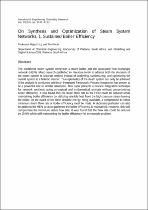 ResearchSpace
ResearchSpace
On synthesis and optimization of steam system networks. 1. Sustained boiler efficiency
JavaScript is disabled for your browser. Some features of this site may not work without it.
- ResearchSpace
- →
- Research Publications/Outputs
- →
- Journal Articles
- →
- View Item
| dc.contributor.author |
Majozi, T

|
|
| dc.contributor.author |
Price, T

|
|
| dc.date.accessioned | 2014-08-27T12:38:23Z | |
| dc.date.available | 2014-08-27T12:38:23Z | |
| dc.date.issued | 2010-08 | |
| dc.identifier.citation | Majozi, T and Price, T. 2010. On synthesis and optimization of steam system networks. 1. Sustained boiler efficiency. Industrial & Engineering Chemistry Research, vol. 49(19), pp 9143-9153 | en_US |
| dc.identifier.issn | 0888-5885 | |
| dc.identifier.uri | http://pubs.acs.org/doi/ipdf/10.1021/ie1007008 | |
| dc.identifier.uri | http://hdl.handle.net/10204/7641 | |
| dc.description | Copyright: 2010 American Chemical Society. This is an ABSTRACT ONLY. The definitive version is published in Industrial & Engineering Chemistry Research, vol. 49(19), pp 9143-9153 | en_US |
| dc.description.abstract | The traditional steam system comprises a steam boiler and the associated heat exchanger network (HEN). Most research published in literature tends to address both the elements of the steam system as separate entities instead of analyzing, synthesizing, and optimizing the overall system in a holistic manner. True optimality of the steam system can only be achieved if the analysis is conducted within an integrated framework. Process integration has proven to be a powerful tool in similar situations. This paper presents a process integration technique for network synthesis using conceptual and mathematical analysis without compromising boiler efficiency. It was found that the steam flow rate to the HEN could be reduced while maintaining boiler efficiency by utilizing sensible heat from the high pressure steam leaving the boiler. In the event of too little sensible energy being available, a compromise in either minimum steam flow rate or boiler efficiency must be made. A dedicated preheater can also be added to the HEN so as to guarantee the boiler efficiency is maintained; however, this will compromise the minimum steam flow rate. It was found that the flow rate could be reduced by 29.6% while still maintaining the boiler efficiency for an example problem. | en_US |
| dc.language.iso | en | en_US |
| dc.publisher | American Chemical Society | en_US |
| dc.relation.ispartofseries | Workflow;5084 | |
| dc.subject | Steam system networks | en_US |
| dc.subject | Sustained boiler efficiency | en_US |
| dc.subject | Boiler efficiency | en_US |
| dc.subject | Heat exchanger network | en_US |
| dc.title | On synthesis and optimization of steam system networks. 1. Sustained boiler efficiency | en_US |
| dc.type | Article | en_US |
| dc.identifier.apacitation | Majozi, T., & Price, T. (2010). On synthesis and optimization of steam system networks. 1. Sustained boiler efficiency. http://hdl.handle.net/10204/7641 | en_ZA |
| dc.identifier.chicagocitation | Majozi, T, and T Price "On synthesis and optimization of steam system networks. 1. Sustained boiler efficiency." (2010) http://hdl.handle.net/10204/7641 | en_ZA |
| dc.identifier.vancouvercitation | Majozi T, Price T. On synthesis and optimization of steam system networks. 1. Sustained boiler efficiency. 2010; http://hdl.handle.net/10204/7641. | en_ZA |
| dc.identifier.ris | TY - Article AU - Majozi, T AU - Price, T AB - The traditional steam system comprises a steam boiler and the associated heat exchanger network (HEN). Most research published in literature tends to address both the elements of the steam system as separate entities instead of analyzing, synthesizing, and optimizing the overall system in a holistic manner. True optimality of the steam system can only be achieved if the analysis is conducted within an integrated framework. Process integration has proven to be a powerful tool in similar situations. This paper presents a process integration technique for network synthesis using conceptual and mathematical analysis without compromising boiler efficiency. It was found that the steam flow rate to the HEN could be reduced while maintaining boiler efficiency by utilizing sensible heat from the high pressure steam leaving the boiler. In the event of too little sensible energy being available, a compromise in either minimum steam flow rate or boiler efficiency must be made. A dedicated preheater can also be added to the HEN so as to guarantee the boiler efficiency is maintained; however, this will compromise the minimum steam flow rate. It was found that the flow rate could be reduced by 29.6% while still maintaining the boiler efficiency for an example problem. DA - 2010-08 DB - ResearchSpace DP - CSIR KW - Steam system networks KW - Sustained boiler efficiency KW - Boiler efficiency KW - Heat exchanger network LK - https://researchspace.csir.co.za PY - 2010 SM - 0888-5885 T1 - On synthesis and optimization of steam system networks. 1. Sustained boiler efficiency TI - On synthesis and optimization of steam system networks. 1. Sustained boiler efficiency UR - http://hdl.handle.net/10204/7641 ER - | en_ZA |





